AI in Education Statistics
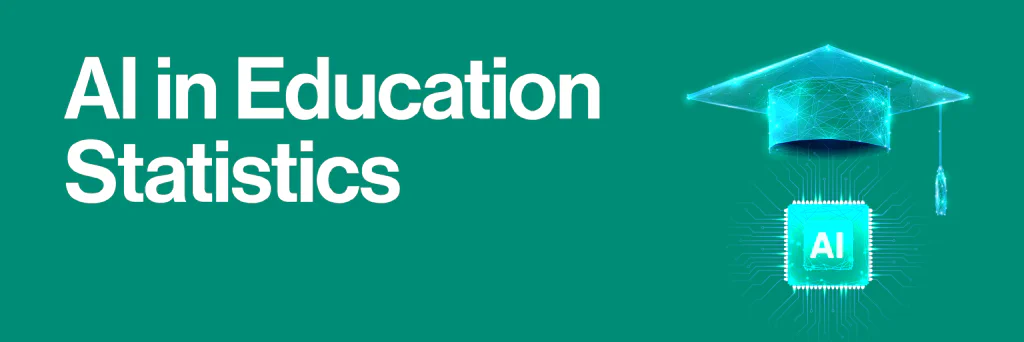
Software within education is increasingly incorporating AI technologies (such as deep learning, machine learning, and natural language processing (NLP)) to help educators facilitate the student learning experience and enhance performance.
By reducing costs, increasing administrative effectiveness, and improving IT security, the introduction of AI in education has benefited educational institutions immensely – a trend likely to continue.
With that in mind, AIPRM has created the ultimate AI in education report, documenting the latest AI in education statistics for 2024. This includes topics such as the use of AI in education, attitudes towards AI in the education sector from teachers, parents, and students, and what the future holds for this developing technology.
Overview: Top 10 AI in education statistics #
- The global AI in education market was worth £2.5 billion in 2022 and is expected to reach $6 billion by 2025.
- Around two-fifths (44%) of children actively engage with generative AI, with more than half (54%) using it for schoolwork and/or homework.
- Three in five (60%) teachers claim to have integrated AI into their daily teaching practices.
- The most common AI tools used in education by teachers are AI-powered educational games, used by more than half (51%) of teachers.
- The most common AI tools used in primary education (K-12) are virtual learning platforms, such as Google Classroom, used by 80% of teachers at least once a week.
- Almost two-fifths (39%) of students use generative AI for curiosity purposes (i.e. to try it out).
- More than half (53%) of students in higher education were using AI to create material for work they would be marked on.
- Incidents of AI and cheating in schools were reported by around a quarter (24.11%) of charter high school students, compared to just 6.44% for private high schools and 15.2% for public institutions.
- Around half (51%) of teachers feel that the use of AI in education will have a positive impact, compared to just over a fifth (21%) who hold negative views.
- More than a third (34%) of students feel that AI is a good thing for education, compared with a fifth (20%) who perceive it as negative.
Global AI in education market statistics #
As of 2022, the global AI in education market was valued at $2.5 billion. With as many as 30 multi-million-dollar-funded AIED corporations, this figure is expected to reach $6 billion by 2025.
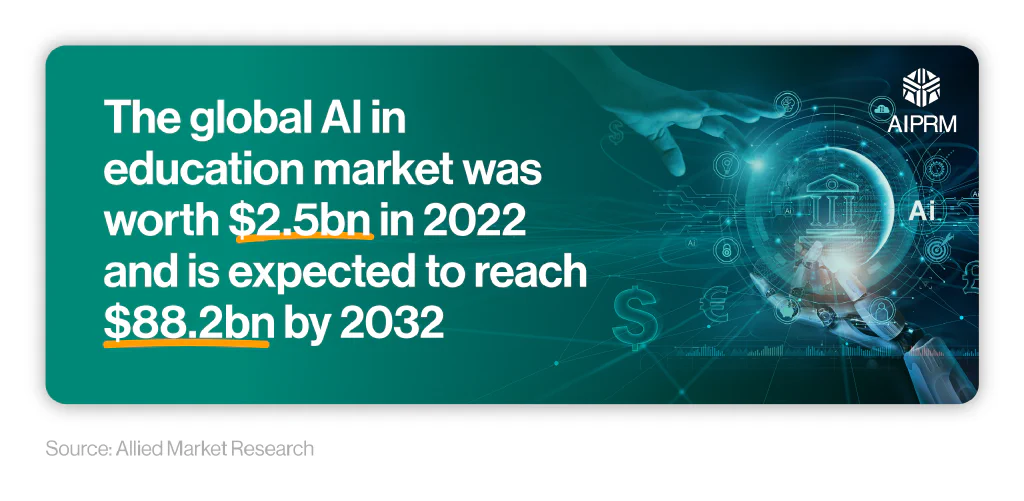
By 2032, this is predicted to reach $88.2 billion, at a compound annual growth rate (CAGR) of more than two-fifths (+43.3%) between 2023-32.
AI in education market size by component #
When broken down by component, the solution segment held the majority market share in 2022, at more than two-thirds of global AI in education revenue. AI services in education display the fastest CAGR of +45.6% between 2023-32, due to a growing knowledge of learning patterns, efficacy, and student outcomes.
By technology, machine learning and deep learning are expected to have the biggest market share by 2032, accounting for more than two-thirds of the overall global AI in education market. Natural language processing (NLP) has a forecasted CAGR of +46.6% during this period as the communication and interaction between people and machines continue to develop.

By application, the learning platform and virtual facilitators segment accounted for around two-fifths of the global AI in education market for 2022. By 2032, the fraud and risk management segment is predicted to see the fastest CAGR at +47.2% as educational institutions look to enhance the reliability of their security measures.
Regional AI in education market size #
North America held the greatest share of the global AI in education market for 2022, accounting for nearly two-fifths of total revenue. The Asia-Pacific region is predicted to have the fastest CAGR, increasing by almost half (+48%) between 2023-32, due to a rapidly expanding population and growing emphasis on education within the region.
Statistics on AI use in education #
Research by Internet Matters found that a quarter of children use AI tools to complete or help with their schoolwork.
Results from their survey indicate that:
- Around two-fifths (44%) actively engaged with generative AI in some capacity, including half of 13-14-year-olds.
- More than a third (35%) expressed a positive view of generative AI.
- Three in five (60%) parents say their child(ren)’s school has not informed them about plans to use generative AI tools as part of a wider teaching strategy.
- Three in five (60%) schools have not spoken to students about using AI in their schoolwork or homework.
- More than half (54%) of children using generative AI do so for schoolwork and/or homework.
- Around two in five (41%) children classed as vulnerable* use ChatGPT for schoolwork and/or homework.
*A vulnerable child is defined as being at greater risk from physical or emotional harm, or those likely to achieve poor outcomes due to factors in their lives. This could include physical, emotional, health, and/or family-related issues that may have knock-on effects on their academic performance.
A breakdown of the extent to which teachers have integrated AI into their daily teaching practices #
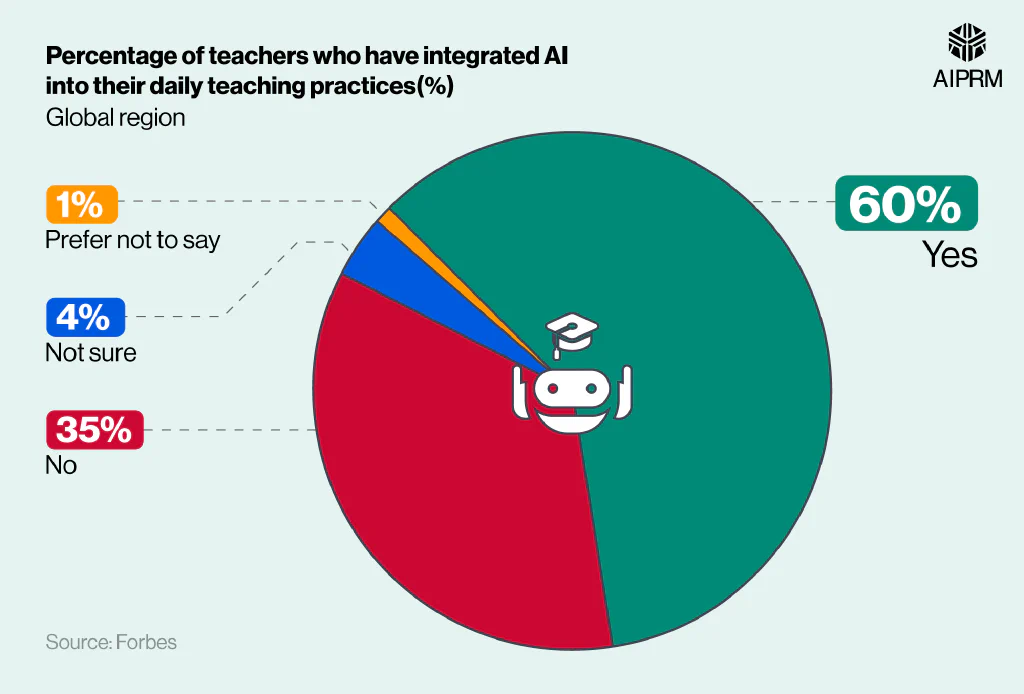
Approximately three in five (60%) teachers interviewed by Forbes claim to have integrated AI into their daily teaching practices, with around one in three (35%) saying they haven’t.
For more information, check out our beginner’s guide to ChatGPT.
AI in primary education statistics #
Around one in five (19%) primary teachers (K-12) claim to have used AI as part of their teacher training program, with just under half of these classed as “active seekers”.
Conversely, two-thirds (66%) of those surveyed admit to not using AI while training to become a teacher.
A breakdown of the extent to which teachers in primary education (K-12) used AI in their training #
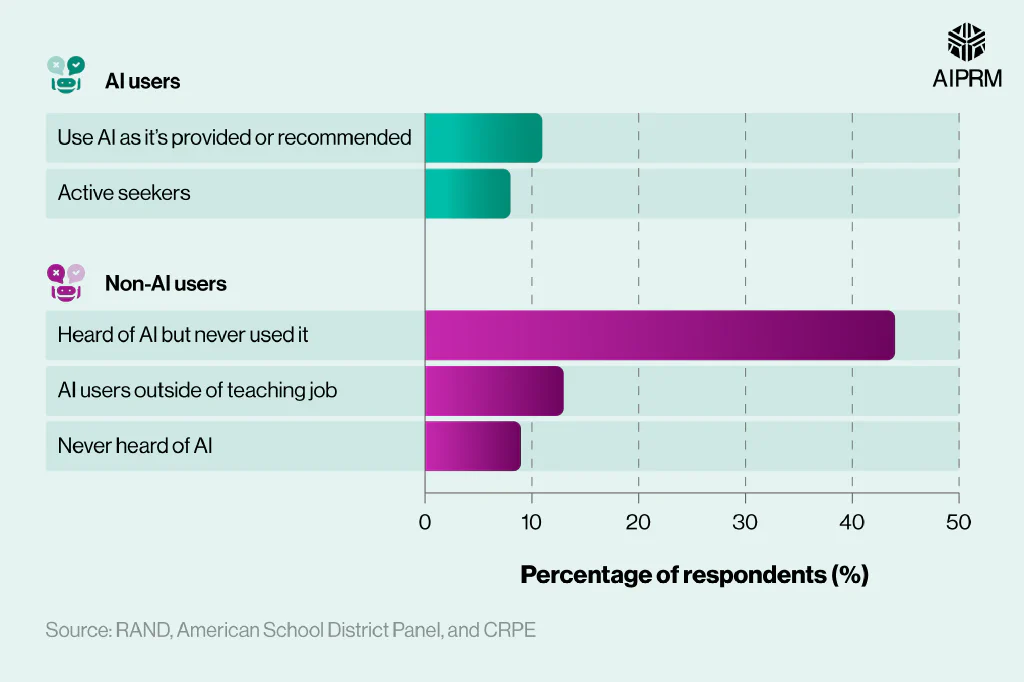
Just under half (44%) had heard of AI, but never used it at this point in their training, with around one in 10 (9%) having never heard of AI at all.
A breakdown of AI use in primary education by school characteristics #
| School characteristic | Percentage of AI users (%) |
|---|---|
| Urban | 17% |
| Suburban | 21% |
| Rural | 16% |
| Low poverty | 19% |
| High poverty | 18% |
| Majority white | 17% |
| Majority students of color | 20% |
(Source: RAND, American School District Panel, and CRPE)
When broken down by school characteristics, primary teachers (K-12) tend to use AI more in a suburban setting (21%) compared to urban (17%) or rural (16%).
There was very little difference between those working in schools of high and low poverty levels (18% vs 19%, respectively), while those working predominantly with students of color had marginally higher rates of AI usage (20%) compared to those with a majority white student population (17%).
A breakdown of AI use in education by teacher characteristics #

A joint study by RAND, American School District Panel, and CPRE, also found that those with less than 10 years of teaching experience tend to have slightly higher rates of AI usage in schools (21%) compared to those who have been in the profession longer than 10 years (17%).
Around a quarter (23%) of those working in 6th-8th grade and 9th-12th grade use AI in their jobs, compared to just over one in 10 (12%) of K-5th grade teachers.
When broken down by primary subject, more than a quarter (27%) of those teaching ELA or social studies use AI in their jobs, compared to around one in 10 (11%) for elementary teachers.
Did you know English is the most studied language in the world? But, this can be challenging for those who haven’t grown up in English-speaking countries. Thankfully, AI tools in the ESL classroom are there to help facilitate the learning of English to people from all backgrounds and walks of life.
A breakdown of AI training opportunities provided by US primary schools (K-12) #
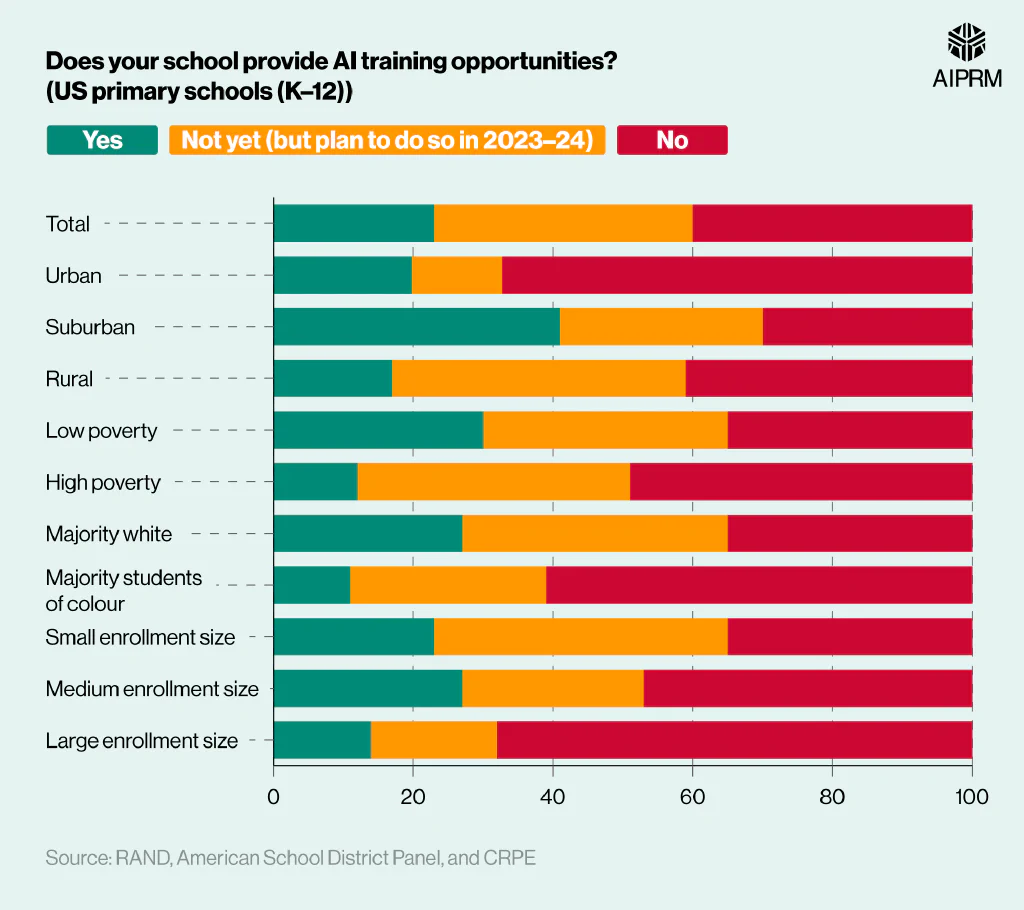
When looking at AI training opportunities provided by primary schools (K-12), those in suburban areas tend to receive around twice as much compared to urban or rural areas (41% vs 20% and 17%, respectively).
Incidentally, more than two-thirds (68%) of urban primary teachers have not received any AI training since joining the profession.
The study by RAND, American School District Panel, and CPRE also found that:
- Less than a third (30%) of those working in low-poverty schools have received AI training opportunities compared to around one in 10 (12%) in high-poverty areas.
- More than a quarter (27%) of teachers working with predominantly white students had the opportunity for AI training. This was contrasted with around one in 10 (11%) for those mainly teaching students of color.
- For primary teachers with a student population mainly consisting of students of color, around three-fifths (61%) had received no training compared to just over a third (35%) for teachers of mainly white students.
- Schools with a medium-sized enrollment tend to get slightly more training than smaller establishments (27% vs 23%, respectively), yet more than two-thirds (68%) of those with large enrollment sizes receive comparatively little in terms of AI professional development.
- More than two-fifths (42%) of medium-sized primary schools are planning to introduce AI training opportunities for staff within the 2023-24 academic year, compared to just under a fifth (18%) for large establishments.
Most common AI tools used in education #
The most common AI tools used in education by teachers are AI-powered educational games.
When surveyed by Forbes, just over half (51%) of teachers admitted using AI for this purpose, with a further two-fifths claiming to use either adaptive learning platforms (43%) and/or automated grading and feedback systems (41%).
A breakdown of the most common AI tools used in education #
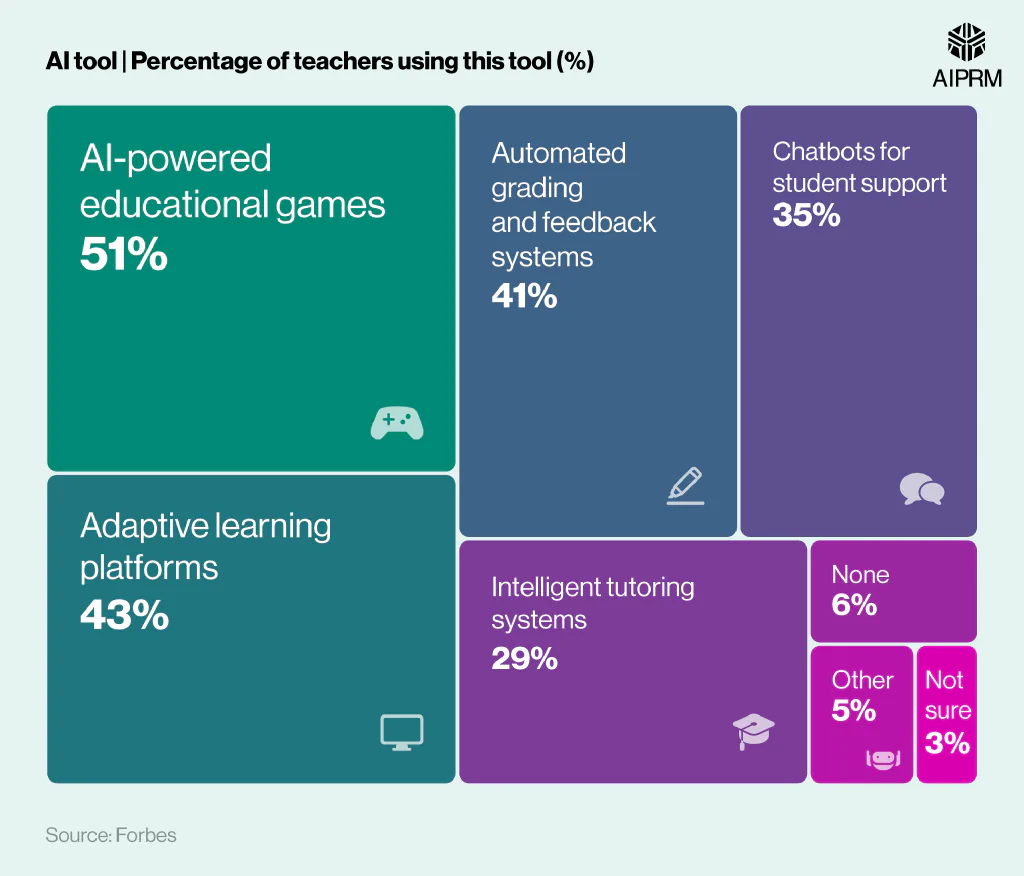
More than a third (35%) of teachers admitted using chatbots as a means of student support, with just under one in three (29%) incorporating AI in education as part of an intelligent tutoring system.
Want to learn more about how AI can help your teaching practice? We have a variety of tutorials available, from the basics for those just getting started with AIPRM to expert tools for more established users, including how to create prompts.
A breakdown of the most common AI tools used in primary education (K-12) #
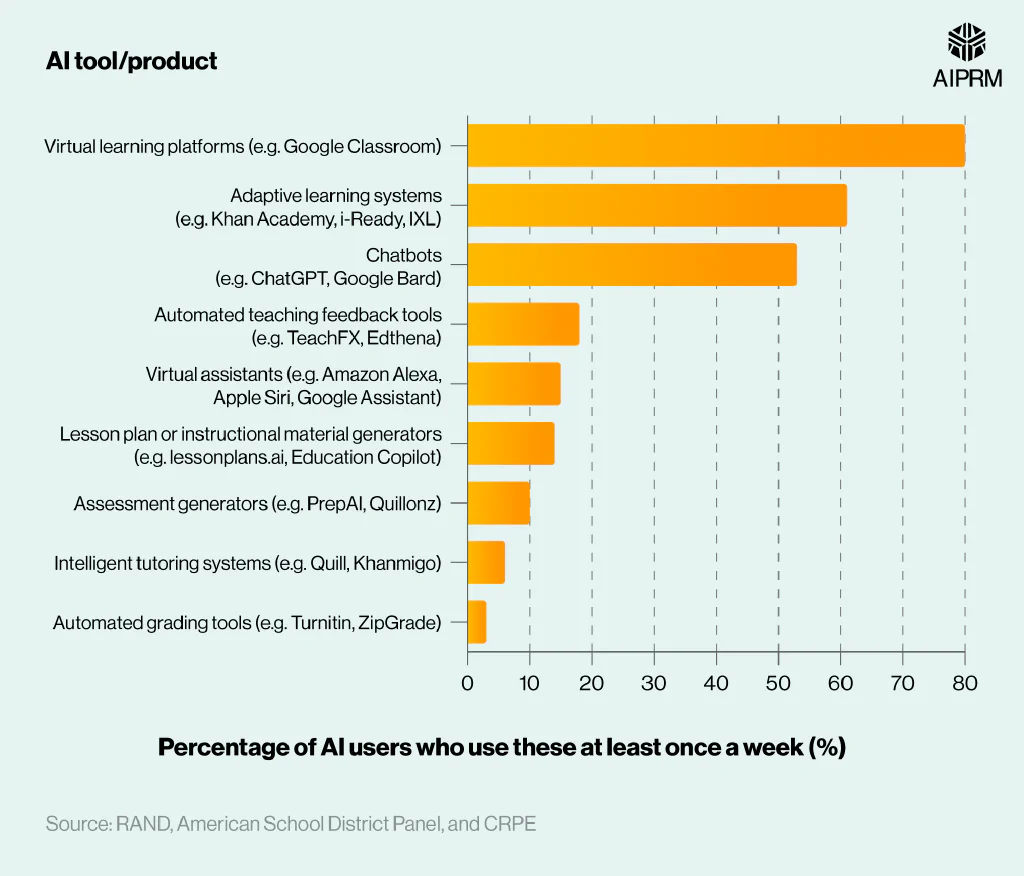
The most common types of AI used in primary education by teachers are virtual learning platforms (such as Google Classroom), with four in five (80%) professionals claiming to use these at least once a week.
Adaptive learning systems (such as Khan Academy, i-Ready, and IXL) are the next most popular AI tools within a primary classroom (K-12), with approximately three-fifths (61%) admitting to using these AI systems each week with their students.
Incidentally, just over half (53%) of primary teachers (K-12) are using chatbots, such as ChatGPT and Google Bard, with their students every week.
Want to create lesson plans that are engaging, interactive, and seemingly effortless? Check out our course creator prompt to help save you time in creating those memorable lessons that students crave.
A breakdown of the most common ways to use AI tools in primary education (K-12) #
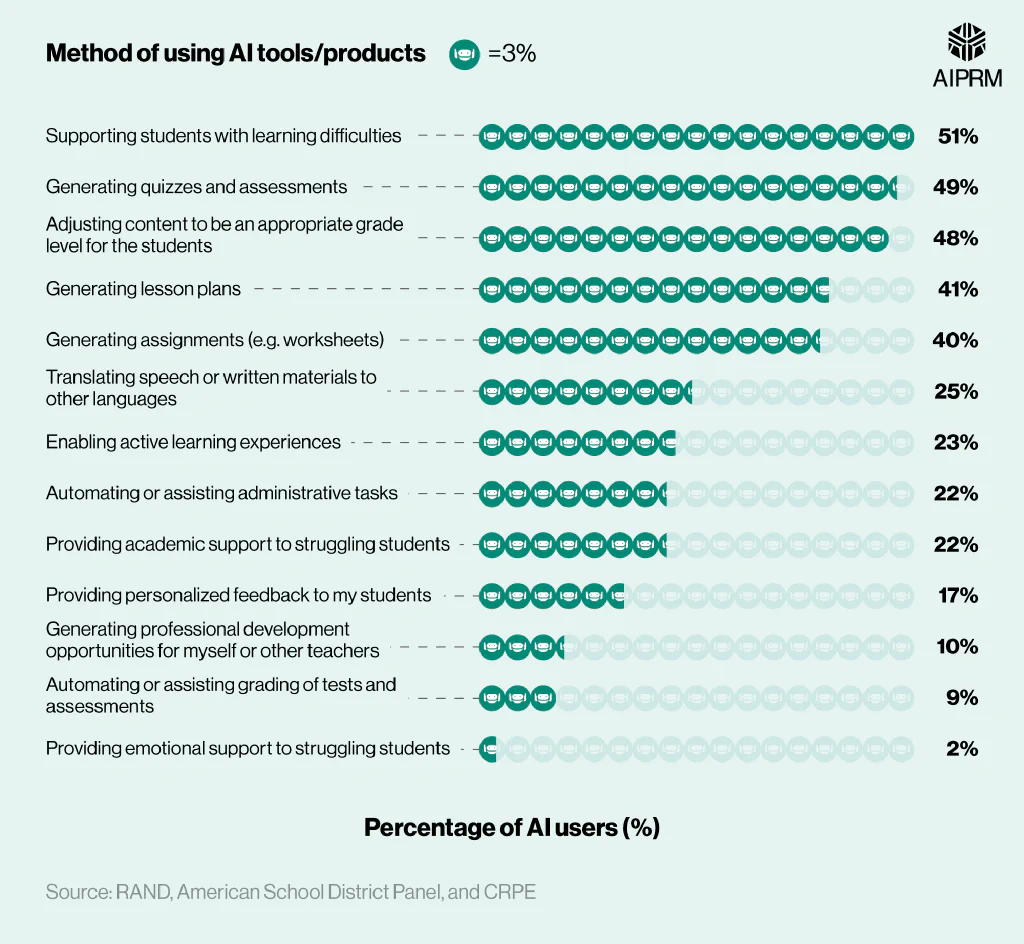
Those in primary education (K-12) are using AI tools within the classroom to help students in a variety of ways.
Around half of the teachers surveyed use AI tools to support students with learning difficulties (51%). A similar percentage focuses on the creation of assessments/quizzes (49%) and adjusting lesson content to an appropriate level for the students (48%).
Approximately two in five teachers use AI tools as part of their lesson planning (41%) and/or to generate assignments/worksheets (40%).
A breakdown of the most common AI tools used by students (11-17) #
| AI tool | Percentage of children aged 11-17 who have used it (%) |
|---|---|
| ChatGPT/GPT-4 | 23% |
| My AI by Snapchat | 23% |
| Bing Chat | 10% |
| Gemini by Google | 9% |
| Billie chatbot by Instagram | 8% |
| Replika | 5% |
| DALL-E | 4% |
| Stable Diffusion | 4% |
(Source: Internet Matters)
Around a quarter of students (23%) aged 11-17 admit to using either ChatGPT/GPT-4 and/or My AI by Snapchat, making these the most popular AI tools among teenagers.
Want to learn the basics about ChatGPT? Check out our tutorial on how to create a ChatGPT account to start your journey into the world of AI content creation.
A breakdown of student ChatGPT awareness and usage between different income groups #
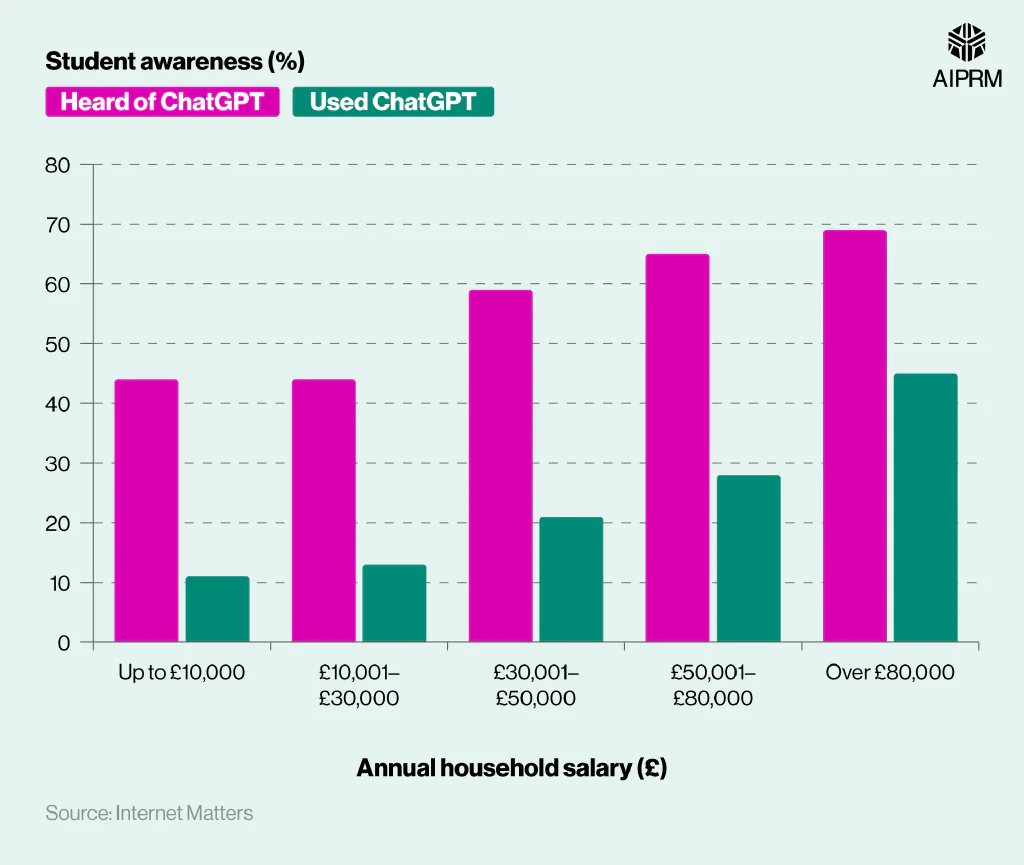
Generally speaking, as annual household salary increases so does the percentage of students who have heard and used ChatGPT.
More than two-fifths (44%) of students from households on low incomes (less than £10,000 a year) and mid-low incomes (£10,001 - £30,000 a year) have heard of ChatGPT, with around a quarter (24%) having used the application.
These figures rise to more than two-thirds (69%) of households earning more than £80,000 a year who have heard of ChatGPT, and more than two-fifths (45%) for those who have used it.
A breakdown of the most common ways in which students use ChatGPT #
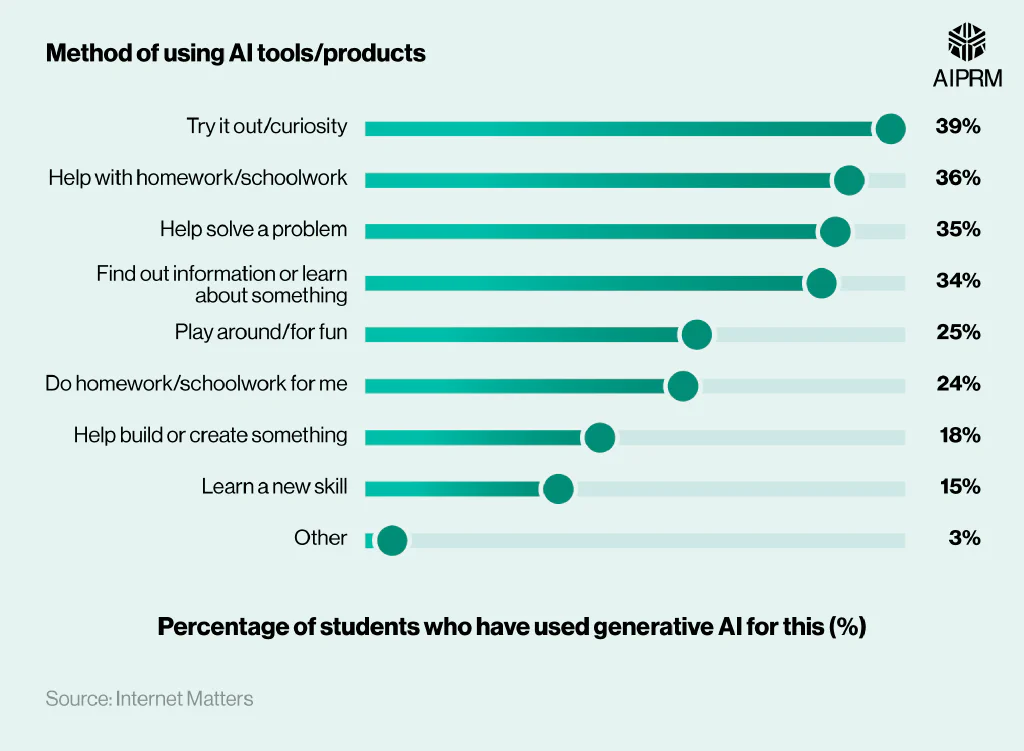
Research by Internet Matters found that almost two-fifths (39%) of students use generative AI to try it out for curiosity purposes.
This was followed closely by education reasons, with more than a third using it to help with homework/schoolwork (36%), solving a problem (35%), and/or finding out information (34%).
A breakdown of the most common uses of AI in the education sector (teachers vs students) #
| Use of AI | Teacher | Student |
|---|---|---|
| Research | 44% | 44% |
| Generating lesson plans | 38% | - |
| Summarizing or synthesizing information | 38% | 38% |
| Generate study guides or materials | - | 33% |
(Source: Quizlet via PR Newswire)
The most common use of AI in the classroom for both teachers and students is for research purposes, with more than two-fifths (44%) claiming to use AI for this reason.
An identical percentage (38%) of teachers and students claim to use AI for summarizing or synthesizing information, with the same figure representing teachers who use AI for lesson planning.
In addition, the State in Education Report by Quizlet also suggests that:
- AI is gaining traction in the education sector, both in terms of uptake and sentiment. However, it’s far from ubiquitous, with more than a third (35%) of teachers not yet having tried AI tools.
- More than half (53%) of students claim their teachers have yet to talk to them about the use of AI technology in their education and how it relates to their school work.
- Almost three-fifths (59%) admit their teachers have not encouraged them to try AI technologies to date.
One explanation for this trend could be the lack of school or district-wide guidance relating to the use of AI in education. Only around a fifth (22%) of students and teachers report having a code of conduct or advisory for AI technologies within their establishments.
In addition, another highly contested topic within the realm of education is equity – enabling all students to have the same educational opportunities regardless of their background.
A breakdown of the extent to which teachers and students think the use of AI in education creates equity #
| View | Overall | Teacher | Student |
|---|---|---|---|
| AI creates a more equitable educational system | 42% | 47% | 38% |
| AI has no impact on equity within education | 24% | - | - |
(Source: Quizlet via PR Newswire)
More than two-fifths (42%) of those surveyed by Quizlet felt that AI creates a more equitable system in the world of education – a view held by almost half (47%) of teachers and around two-fifths (38%) of students.
Statistics on the use of AI in higher education #
Since the release of ChatGPT in November 2022, the level of interest in generative AI tools within a higher education setting has exploded. According to ChatGPT statistics, there were approximately 180 million users, as of December 2023, generating an average of 1.7 billion views per month.
Many are excited about its ability to enhance student performance, develop their learning experiences, and make the workload more manageable while at college. Yet others have concerns over its potential downsides, notably AI-based cheating and a reduction in teacher-student interactions.
In a survey of over 1,200 undergraduates, HEPI analyzed the use of AI in higher education and its potential impacts on student learning.
They found that more than half (53%) were using AI in academic writing for work they would be marked on. One in four (25%) were using applications such as Google Bard or ChatGPT to suggest research topics, while more than a third (36%) were using AI to explain concepts.
Want to make your course sound as exciting and compelling as possible for potential students? Check out our course description AI prompt to save you time in writing captivating course content and boost your marketing prowess.
A breakdown of how students use AI in higher education #

Further research from HEPI also found that:
- More than a third (35%) of students who have used generative AI aren’t aware of how often it produces made-up facts, stats, or citations (known as ‘hallucinations’).
- Two-thirds (66%) of students consider it acceptable to use generative AI for explaining concepts, but only 3% think it’s acceptable to use it for text in assessments without editing.
- Three in 10 students (30%) agree that their institution should provide AI tools, with fewer than one in 10 (9%) saying they currently do.
- Just over a fifth (22%) of students are satisfied with the support they receive on AI, with around three-fifths (62%) feeling neutral on the matter.
- Almost three-quarters (73%) expect to use AI once they graduate. The majority believe they will use it to translate text (38%), followed by enhancing written content (37%) and summarizing text (33%).
What used to take hours can now be achieved in minutes. Check out these AI prompts to see how you can save time with a variety of tasks, including copywriting, SEO optimization, software engineering, and more.
Benefits and use cases of AI in education #
Virtually all (99.4%) of the 509 U.S. higher education institutions surveyed by Microsoft say that AI in education will be central to their institution’s competitiveness in the years to come.
Alongside this, 15% believe AI will be a game changer, with almost two-fifths (38%) having adopted AI as a core part of their business strategy.
Much research has been conducted into the benefits of AI in education from an anecdotal perspective. Yet some have gone one step further by analyzing the statistical evidence for using AI to enhance student learning and performance.
1. An accuracy rate of 80% (compared to expert human advice) in providing recommendations to students in need of help #
Researchers from Stanford University developed an AI program that helps students when they get stuck during a self-paced, digital learning experience. The machine-learning program was designed to predict when a student was likely to get stuck and start “wheel spinning” (the point at which students repeat problems and aren’t progressing in their task). From this point, the program would recommend a solution.
By analyzing performance data from 1,170 Ugandan students, around half of the pupils “spun their wheels” at least once (defined for this study as making at least 10 attempts to answer a question).
The tool was then tested on six hypothetical students generated from the historical performance data. In four of the six cases, the model and human came up with the same solutions.
With an average of 114 students per class in Uganda, AI tools such as this could be rolled out to many areas of the developing world, where teachers have a limited ability to help every student all the time with one-to-one support.
2. A 91% accuracy rate by AI chatbots in providing personalized help for students #
The University of Murcia in Spain conducted a study to assist students with inquiries about the campus and academic programs on offer. AI-assisted chatbots were able to answer 38,708 questions correctly in around nine out of 10 (91%) occasions. This provided students with responses outside of opening hours and was implemented without any changes to the existing staff structure.
3. An increase of 62% in test scores using adaptive learning #
A study by Knewton, an adaptive-learning company, found that student test scores improved by more than three-fifths (62%) when using their AI-powered learning program compared to those who didn’t.

In a study by more than 10,000 students, the AI was able to personalize content to students based on its algorithm. The product was trained with over 25,000 beta testers to identify knowledge gaps in its users and calculate what content worked best to fill those gaps.
With 90% of its content licensed through open educational resources, the program can keep costs low. This makes it affordable for a greater proportion of the student population and helps generate greater equity within the world of education.
4. 80% accuracy rate in predicting students’ final grades to help thousands from failing #
Ivy Tech Community College in Indiana conducted a pilot study using data across 10,000 course sections. Within the first two weeks of the semester, it had identified 16,000 students at risk of failing. Using this data, the college was able to put support in place for these students to reduce their risk of failure.
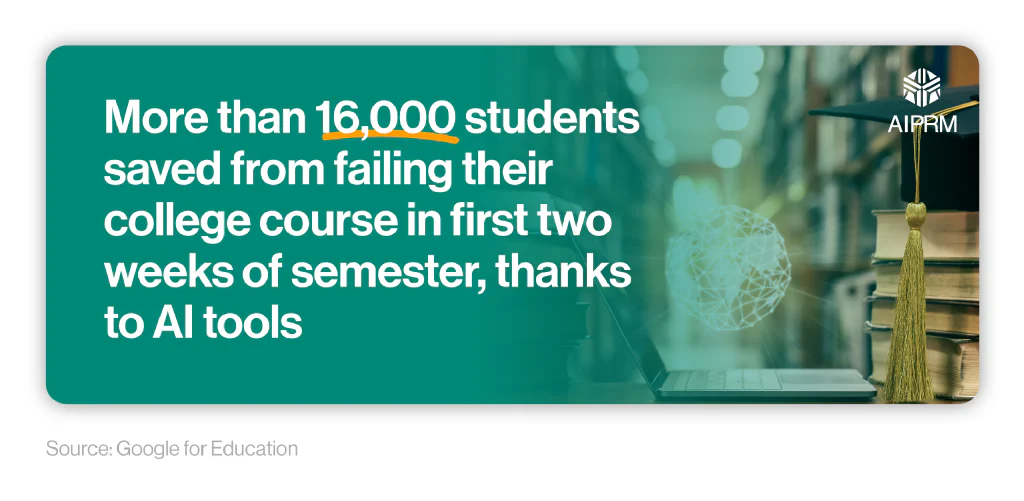
By the end of the semester, 3,000 students were saved from failing, with 98% obtaining a C grade or better.
5. AI-powered grading tool reduces time spent by educators grading assessments by 70% #
Gradescope was designed to streamline the grading process for educators. It operates by allowing students to upload their assignments, which are then sorted and grouped by the program and assigned a grade.
The AI tool was shown to reduce the amount of time teachers spent marking and grading student work by at least 70%.
From here, educators can access a detailed analysis of student performance, allowing for personalized tutoring and targeted intervention in future lessons.
AI and cheating statistics in education #
Cheating in education is certainly not a new phenomenon and pre-dates the introduction of any form of modern AI technology.
For example, a 2012 survey by the Joseph Institute of more than 23,000 high-school students in the U.S. found that three-quarters (75%) admitted copying someone else’s homework, with more than half (52%) reporting cheating on a test within the previous year.
A breakdown of the most common AI cheating methods experienced by teachers #
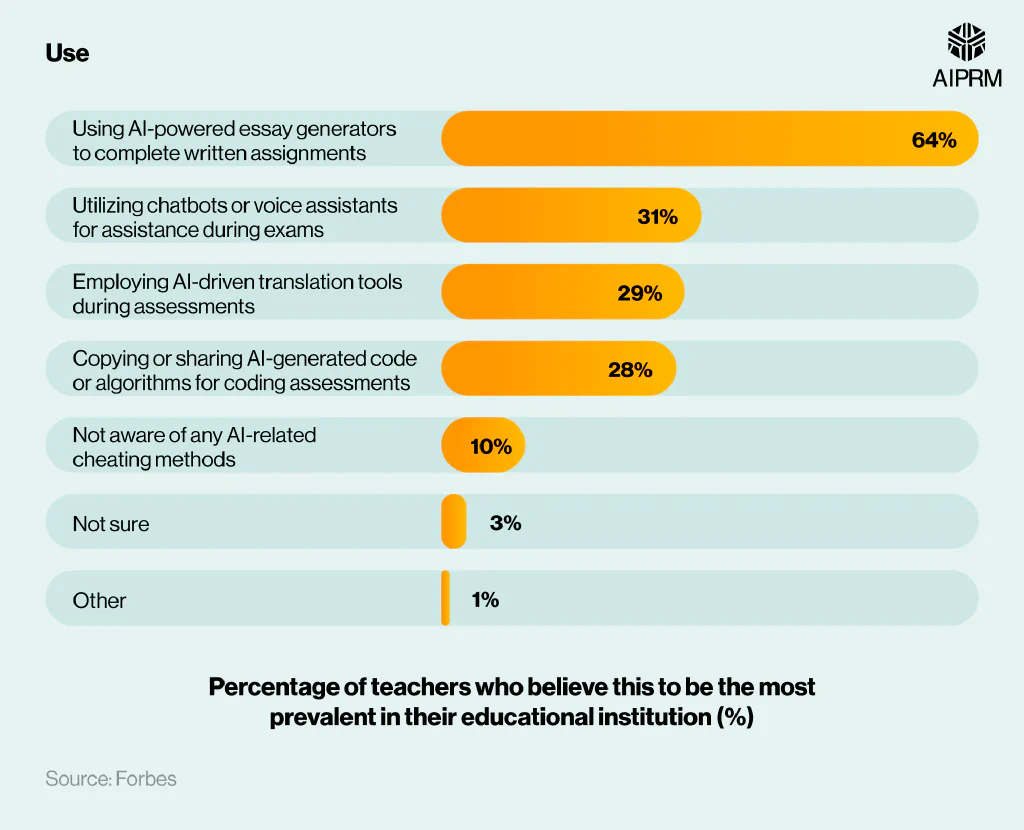
The most common AI cheating method observed in schools by teachers was for those using AI-powered essay generators to complete written assignments. According to a Forbes survey, almost two-thirds (64%) of teachers believed this to be the most prevalent form of cheating using AI in their school.
Around one in three (31%) felt that students were utilizing chatbots or voice assistants during exams, with a slightly smaller percentage (29%) under the impression that students were employing AI-driven translation tools during assessments.
Did you know that AI coding and programming tools are available to assist with your learning while in higher education? However, consult your tutor or course instructor before using them to ensure this is permitted within the rules of your institution.
A breakdown of the most common cheating methods experienced by high school students #
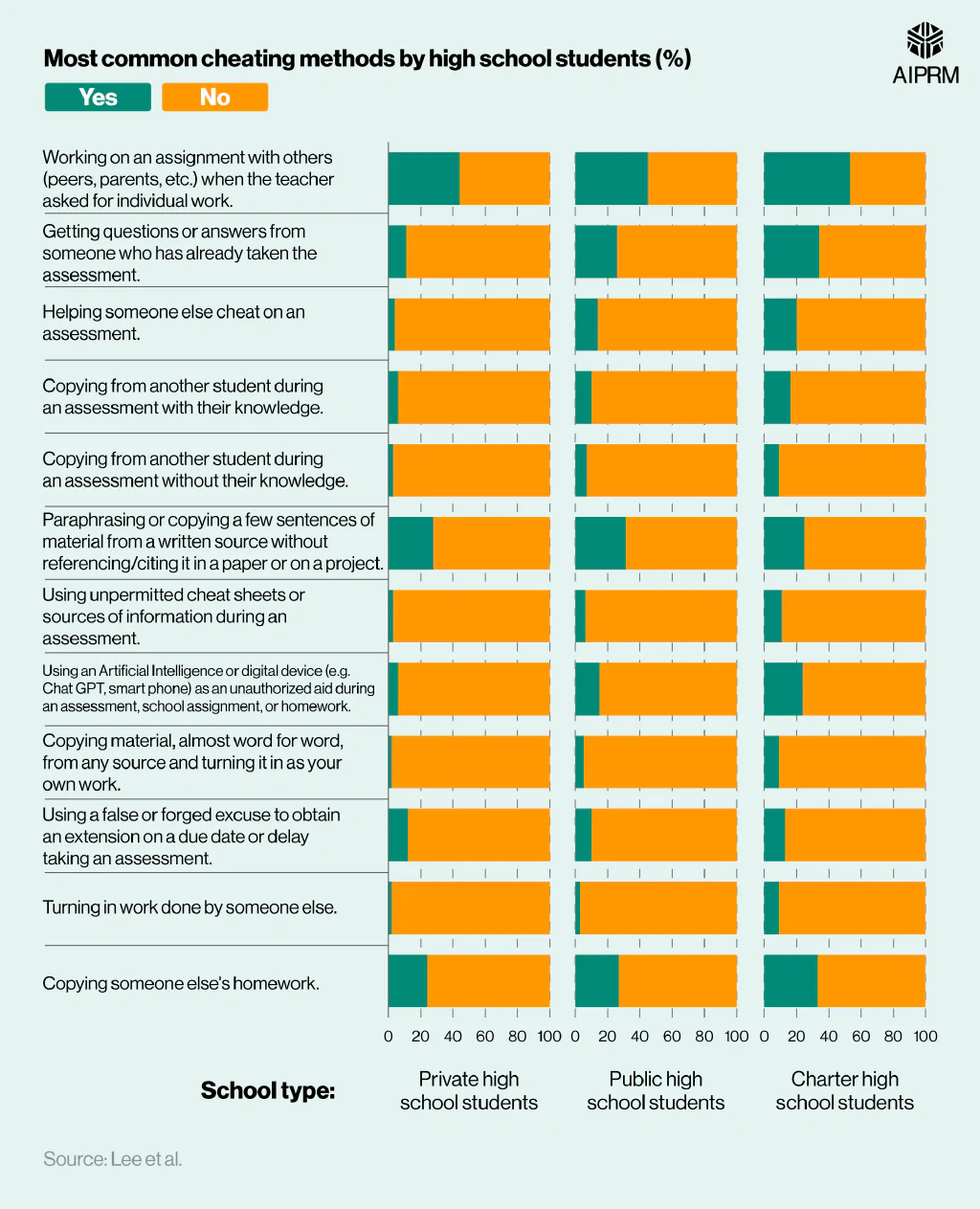
According to a study by Lee et al., incidents of cheating tend to be more prevalent in charter high schools, followed by public and then private institutions (based on reported cases by high school students).
Across all three types of educational institutions, working on an assignment with others when the teacher has asked for individual work was the most reported incident of cheating. This ranged from just over half (52.51%) of charter high school students to a little more than two-fifths (44.06%) of private high school students.
This was followed by students paraphrasing or copying a few sentences of material from a written source without referencing/citing it in their work. This was one of few incidents of reported cheating to buck the overall trend and was higher in private (28.22%) and public high schools (31.2%) compared to charter high schools (24.82%).
Getting questions or answers from someone who had already taken the assessment was around three times more common in charter high schools than private ones (33.65% vs 11.39%, respectively).
In terms of AI and cheating in schools, this was reported by around a quarter (24.11%) of charter high school students, compared to just 6.44% of those from private high schools and 15.2% from public institutions.
A breakdown of AI and cheating statistics across UK universities (2022-24) #
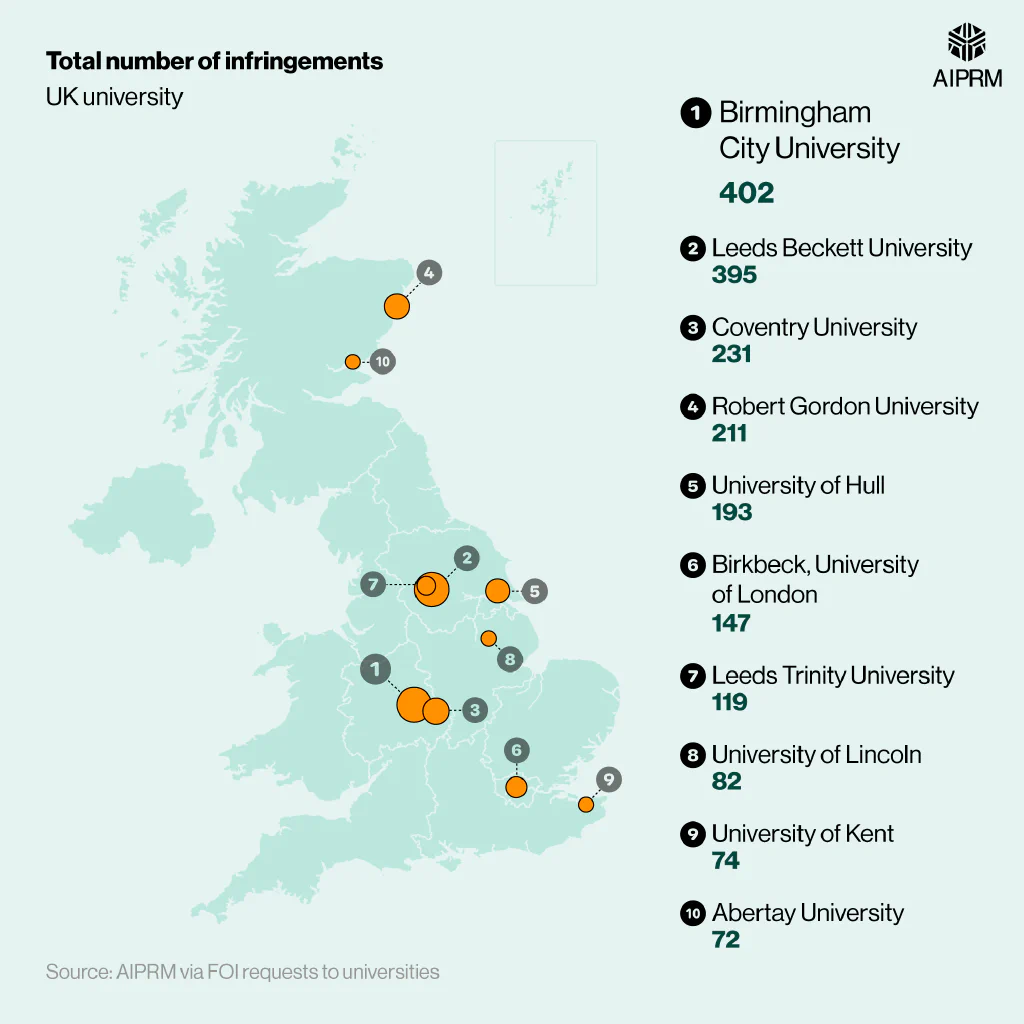
| University | 2022/23 | 2023/24 (to date) | Total |
|---|---|---|---|
| Birmingham City University | 307 | 95 | 402 |
| Leeds Beckett University | 190 | 205 | 395 |
| Coventry University | 231 | N/A | 231 |
| Robert Gordon University | 6 | 205 | 211 |
| University of Hull | 165 | 28 | 193 |
| Birkbeck, University of London | 147 | N/A | 147 |
| Leeds Trinity University | 81 | 38 | 119 |
| University of Lincoln | 30 | 52 | 82 |
| University of Kent | 26 | 48 | 74 |
| Abertay University | 44 | 28 | 72 |
(Source: AIPRM via FOI requests to universities)
In an FOI request to UK universities, AIPRM looked to discover how many students have used AI to cheat and, geographically, where this infringement is most common.
Of the 80 universities that returned data, more than four in five (82.5%) have investigated their students for incidents of AI and cheating.
Students at Birmingham City University were the most likely to cheat using AI, with 402 reported cases between 2022-24. Incidentally, more than three-quarters (76%) of these came in the 2022-23 academic year. By contrast, Birmingham Newman University reported zero offenses across the same period.
Leeds Beckett University follows in second place, with 395 penalties between 2022-24. More than half (51.9%) were reported in the 2023/44 academic year, suggesting a slight rise in cases at this university over time. By contrast, Leeds Trinity had less than half the amount of recorded incidents, while the University of Leeds reported just seven cases across the two academic years.
In 2022/23, Robert Gordon University indicated just six incidents of students cheating using AI. Yet, by the following academic year, this figure had skyrocketed to 205 – an increase of over 3,000% in just 12 months.
Attitudes towards AI in the education sector #
As of 2024, just over half (52%) of people surveyed by YouGov felt that primary schools (K-12) should focus on teaching students how to use AI appropriately – a slight decrease of 2% from 2023.
A breakdown of attitudes towards AI in the education sector #
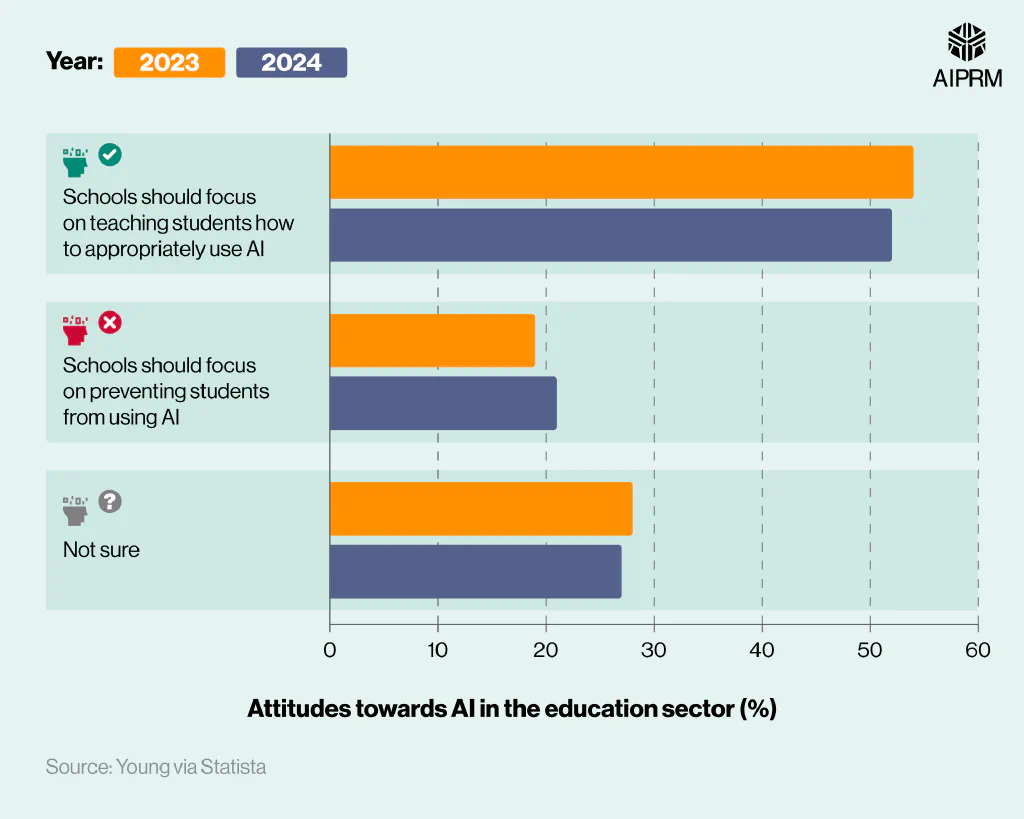
While the overall majority feel that schools should be concentrating on the appropriate use of AI with younger students, just over a fifth (21%) felt that primary schools should instead be focusing on preventing students from using AI – a 2% rise from 2023 figures.
Attitudes towards AI in the education sector by age #
Generally speaking, as age increases so do the feelings of negativity towards the use of AI in education.
According to a 2024 poll by YouGov, just over a quarter (27%) of 18-29-year-olds are very positive about AI and its inclusion in the education sector. This figure drops to just 2% for the over 65s.
Incidentally, just 7% of those aged 18-29 feel very negative about the subject. This figure almost quadruples for the over 65s, where more than a quarter (26%) perceive the use of AI in education to be very negative.
A breakdown of attitudes towards AI in the education sector between age groups #

Overall, almost half (46%) of those between 18-29, and more than two-fifths (41%) aged 30-44, expressed a positive attitude towards AI in the classroom. This was contrasted by just over a fifth (22%) for the 45-64 age group and almost a quarter (23%) for the over 65s.
Conversely, almost half (47%) of those aged 65 and above, and almost two-fifths (37%) of those aged 45-64, were negative about the inclusion of AI in education. This was opposed by just under a quarter (24%) of 30-44-year-olds and just over a fifth (21%) of those aged 18-29.
Attitudes towards AI in the education sector by gender #
Overall, males tend to have a more positive attitude toward AI in the education sector. Just over half (53%) of males believe that schools should focus their attention on teaching students how to use AI appropriately – 2% more than females.
A breakdown of attitudes towards AI in the education sector (male vs female) #
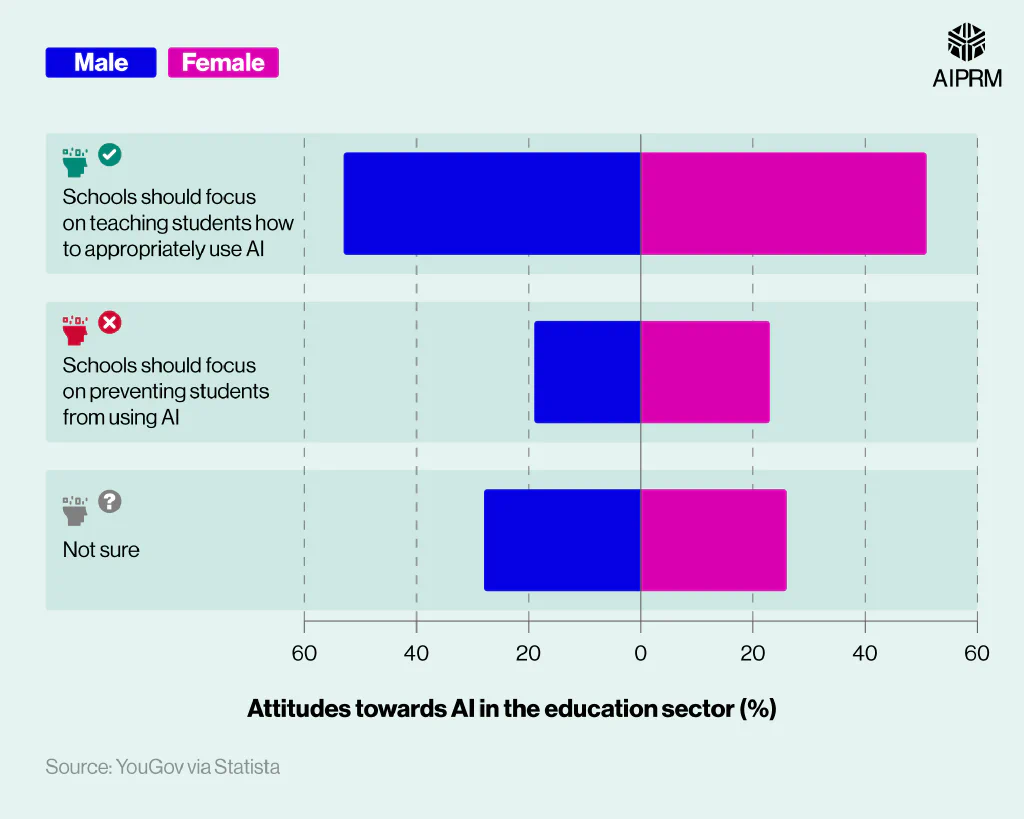
The YouGov survey from 2024 also found that almost a quarter (23%) of females felt schools should instead focus on preventing students from using AI – an opinion shared by just under a fifth (19%) of males.
A breakdown of the extent to which males and females think AI in education has been positive/negative #
| Male | Female | |
|---|---|---|
| Very positive | 12% | 10% |
| Somewhat positive | 25% | 17% |
| Neither positive nor negative | 19% | 20% |
| Somewhat negative | 13% | 18% |
| Very negative | 16% | 18% |
| Not sure | 13% | 17% |
(Source: YouGov via Statista)
In terms of the extent to which males and females think AI in education is a positive thing, this figure stands at almost two-fifths (37%) for males and just over a quarter (27%) for females.
Conversely, almost a third (29%) of males feel a degree of negativity about the use of AI in education – 7% less than their female counterparts (36%).
Teacher attitudes towards AI in the education sector #
According to research by Quizlet, around half (51%) of teachers feel that the use of AI in education will have a positive impact, with a similar percentage (49%) claiming they have already seen the benefits in terms of their workload.
A breakdown of teachers’ attitudes towards AI in the education sector #
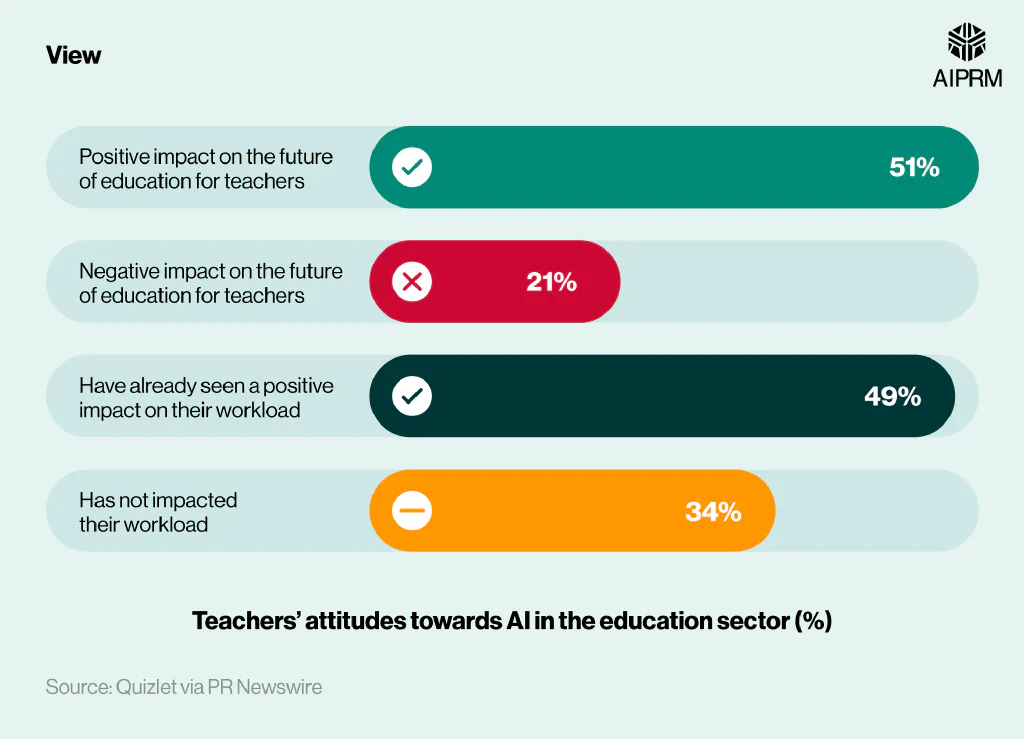
By contrast, just over a fifth (21%) of teachers surveyed felt that AI would harm the future of education for teachers.
A breakdown of attitudes towards AI in the education sector on outcomes #
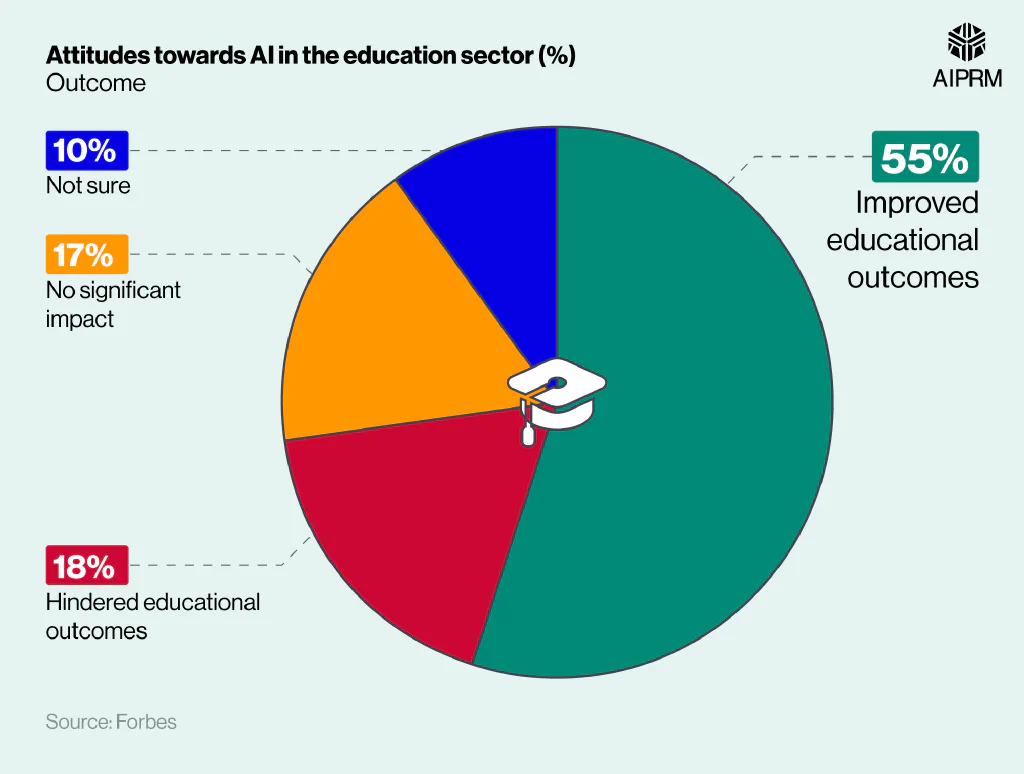
In terms of educational outcomes, more than half (55%) of teachers questioned by Forbes felt that introducing AI into the educational sector would improve student outcomes.
Less than a fifth (18%) believe it will hinder performance, with a similar number (17%) of the opinion it will have no significant impact.
A breakdown of how teachers feel about the use of AI in primary education (K-12) #
| View | Percentage of teachers (%) |
|---|---|
| More benefit than harm | 6% |
| About an equal mix of benefits and harm | 32% |
| More harm than benefit | 25% |
| Not sure | 37% |
| Did not answer | 2% |
(Source: Pew Research Center)
A study by the Pew Research Center found that teacher attitudes toward AI in the primary education sector (K-12) were generally more negative than positive.
A quarter (25%) felt that AI would do more harm than good when it comes to those in 12th grade and below – a contrasted figure of just 6% for those with the opposite opinion.
Almost a third (32%) believe the pros and cons of using AI in a primary education setting are likely to be relatively even.
A breakdown of how teachers feel about the use of AI in education #
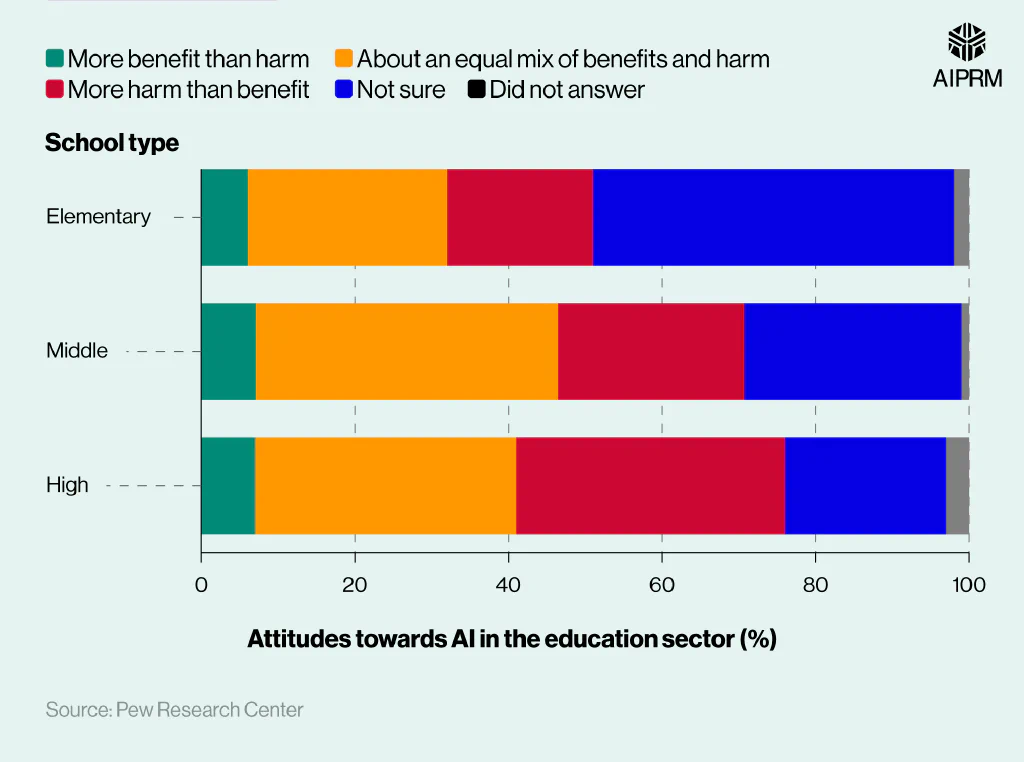
According to findings from the Pew Research Center, teachers believe using AI in education will do more harm than good in a high school setting compared to the elementary level. In all, more than a third (35%) of teachers surveyed feel the negatives of AI will outweigh the positives for high school students, compared to just under a fifth (19%) for elementary students.
Between 6-7% of teachers think AI in education will bring more benefits than harm for students, regardless of their stage in education.
Incidentally, around two-fifths (39%) of teachers agree that AI will bring an even mix of pros and cons for middle school students. This notion is shared by roughly a third of teachers (34%) when it comes to high school students and around a quarter (26%) for those in elementary education.
A breakdown of the most common concerns by teachers when using AI in education #

Almost two-thirds (65%) of teachers surveyed by Forbes are concerned about plagiarism when it comes to using AI in education. Similarly, three-fifths (62%) of professionals believe AI will reduce the amount of human interaction in learning.
Around two-fifths (42%) are worried about data privacy and security, with approximately one in three teachers (30%) raising concerns over both job displacement for teachers and inequality in access to AI-powered resources.
Student attitudes towards AI in the education sector #
More than a third (34%) of students feel that AI is generally a good thing, compared with a fifth (20%) who perceive it as negative.
A breakdown of how students feel about artificial intelligence (in general vs their education) #
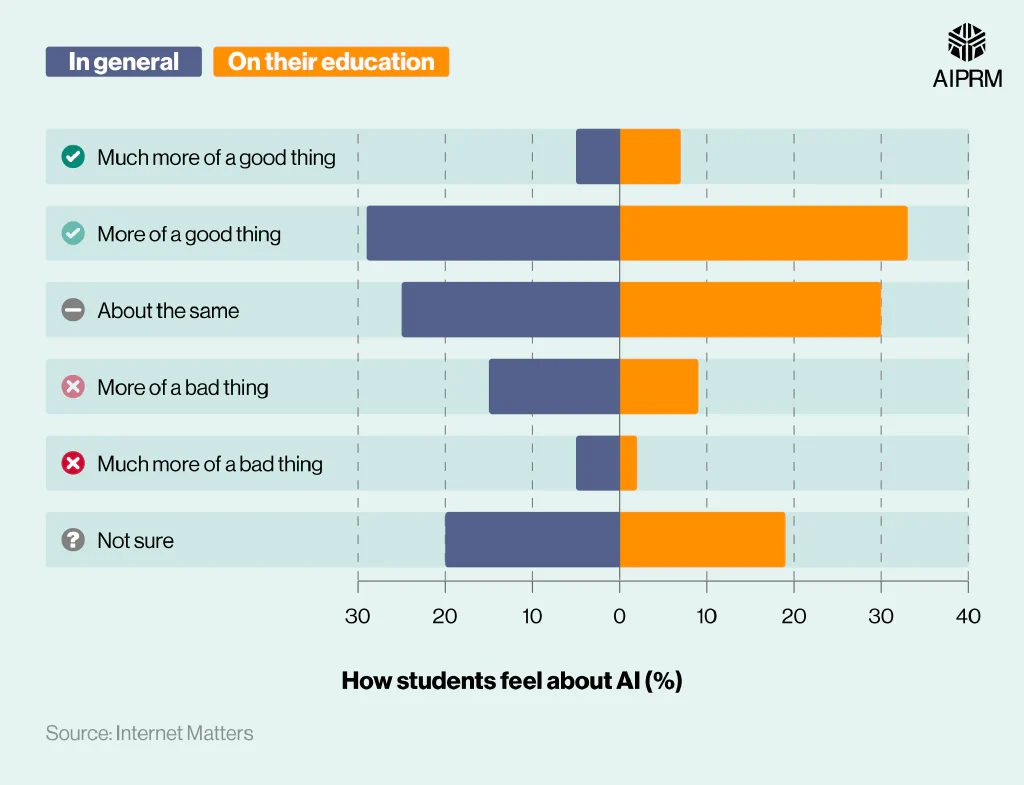
In terms of their education, two-fifths (40%) of students surveyed by Internet Matters were positive about the introduction of AI and could see the benefits. This was contrasted by around one in 10 (11%) who felt AI would have a detrimental impact on their education.
A breakdown of students’ attitudes towards AI in the education sector #
| Number of hours spent studying per weeknight | Percentage of respondents (%) | Have used ChatGPT or similar technologies |
|---|---|---|
| 1-2 | 44% | 61% |
| 3-4 | 29% | 72% |
(Source: Quizlet via PR Newswire)
According to research by Quizlet into student study habits, more than two-fifths (44%) of pupils spend between 1-2 hours per weeknight on studying. Of those, around three-fifths (61%) have used ChatGPT (or similar technologies).
By contrast, less than a third (29%) of students claim to spend 3-4 hours a night on school work during the week, with almost three-quarters (72%) using AI tools such as ChatGPT to complete their work.
Want to experiment and see how ChatGPT can help with your work? Check out these ChatGPT prompts for students to see how they can assist with research, planning, writing, and studying.
Attitudes towards AI in the education sector (teachers vs students) #
Generally speaking, teachers tend to be more positive than students when it comes to the use of AI in education. Research by Quizlet found that almost two-thirds (65%) of teachers have used AI technologies contrasted with just over three-fifths (61%) of students.
A breakdown of attitudes towards AI in the education sector (teachers vs students) #
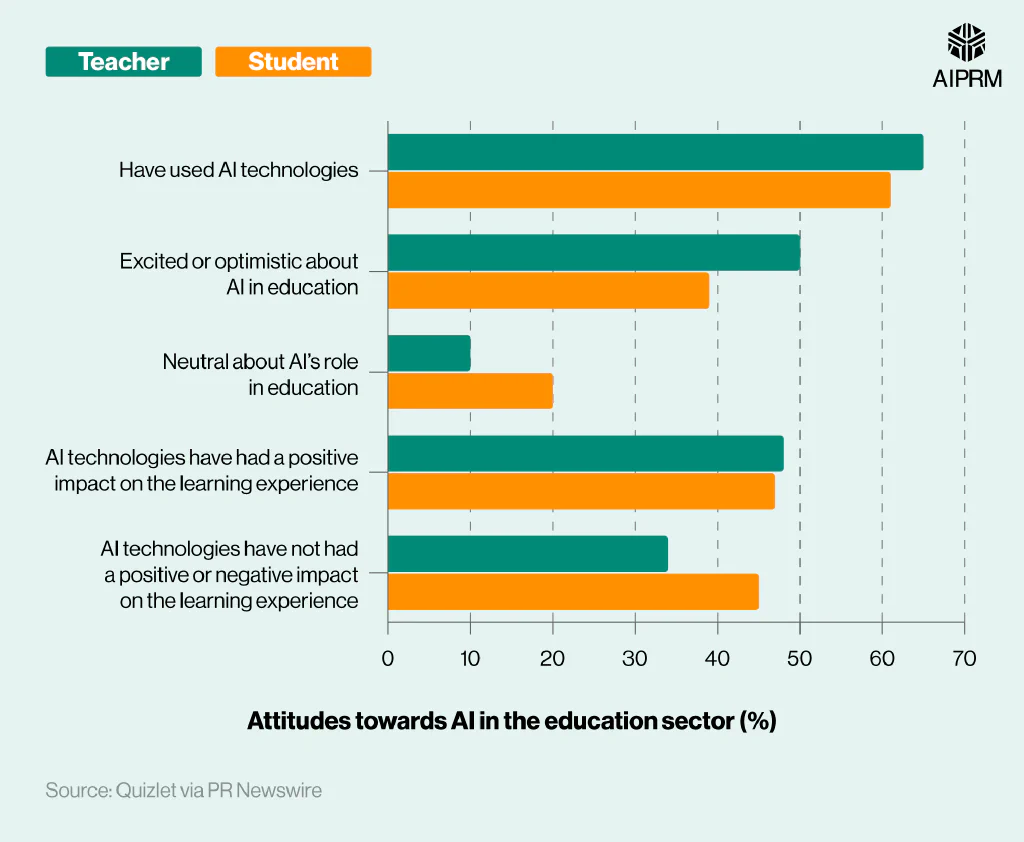
They also found that:
- Half of teachers (50%) were optimistic about the use of AI in education, compared to just under two-fifths (39%) of students.
- Students were twice as likely to be neutral about using AI in their education compared to teachers (20% vs 10%, respectively).
- Almost half of teachers and students (48% vs 47%) think AI has had a positive impact on the learning experience.
- Almost half (45%) of students feel that the impact of AI on learning has been neither positive nor negative, compared to just over a third (34%) of teachers.
Attitudes of parents towards AI in the education sector #
According to a poll by Internet Matters, most parents are concerned about the inclusion of AI in their child(ren)’s life, with over a third (34%) holding this opinion. This is contrasted by around a sixth (16%) who are excited by the prospect of their child(ren) interacting with AI.
A breakdown of how parents feel about artificial intelligence in their child’s life in general #

Less than a third (29%) of parents remain neutral on the matter, with around a fifth (21%) unsure of how they feel.
A breakdown of how often parents have spoken to their child(ren) about AI #
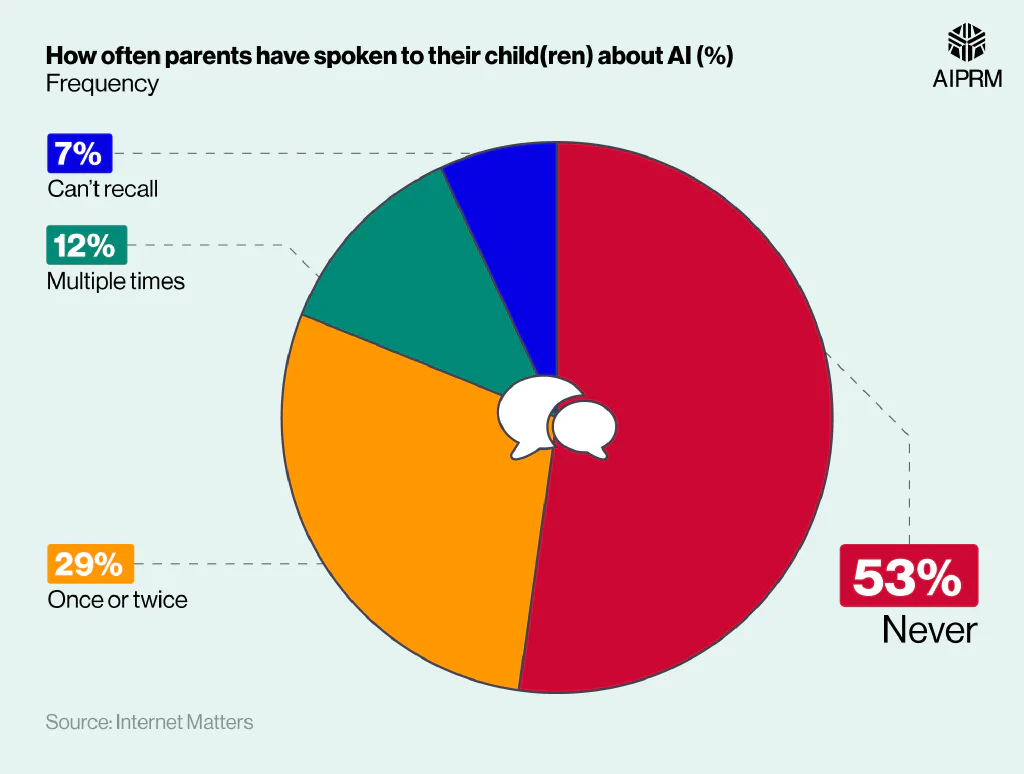
The majority of parents surveyed by Internet Matters have never spoken to their child(ren) about AI, with more than half (53%) admitting this.
Just under a third (29%) have either had one or two conversations with them on the topic, with just over a tenth (12%) claiming to have spoken multiple times with their child(ren) about the subject of AI.
A breakdown of what parents have spoken to their child/children about with regards to AI #
| Topic of conversation | Percentage of parents (%) |
|---|---|
| How AI might be used in the future | 43% |
| What they can be used to do | 39% |
| Rules on how they should and shouldn’t use them | 37% |
| What the tools are/what AI is | 37% |
| The potential risks for them (personally) | 36% |
| The potential risks for society/the world | 33% |
| How to judge whether content produced by AI is truthful | 33% |
(Source: Internet Matters)
Of those parents who have spoken with their children about AI, more than two-fifths (43%) have talked about how AI might be used in the future.
Around a third (33%) have discussed the potential wider risks of AI to society and the world and how to judge whether AI-produced content is truthful.
A breakdown of parents’ perceived impact of AI on their child/children’s education #
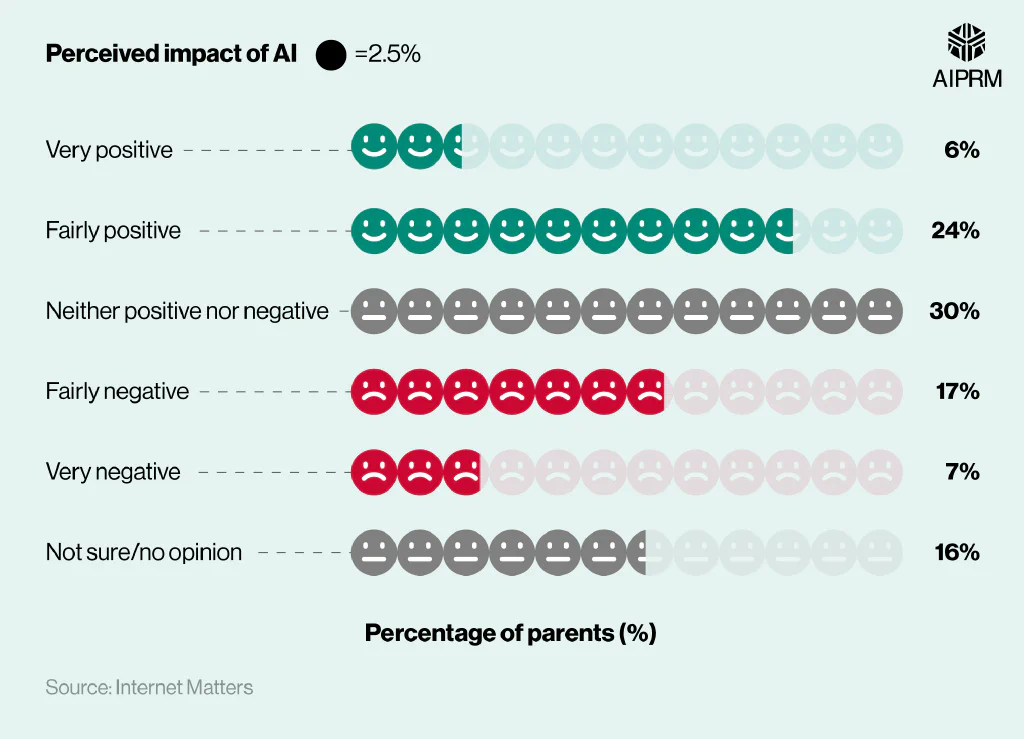
Survey data from Internet Matters suggests that parents tend to have a more positive than negative perception of AI when it comes to their child(ren)’s education.
Just under a third (30%) of parents questioned felt that AI was having a positive impact on education, compared to just under a quarter (24%) who expressed concerns.
A breakdown of attitudes toward AI in the education sector (parents vs students) #
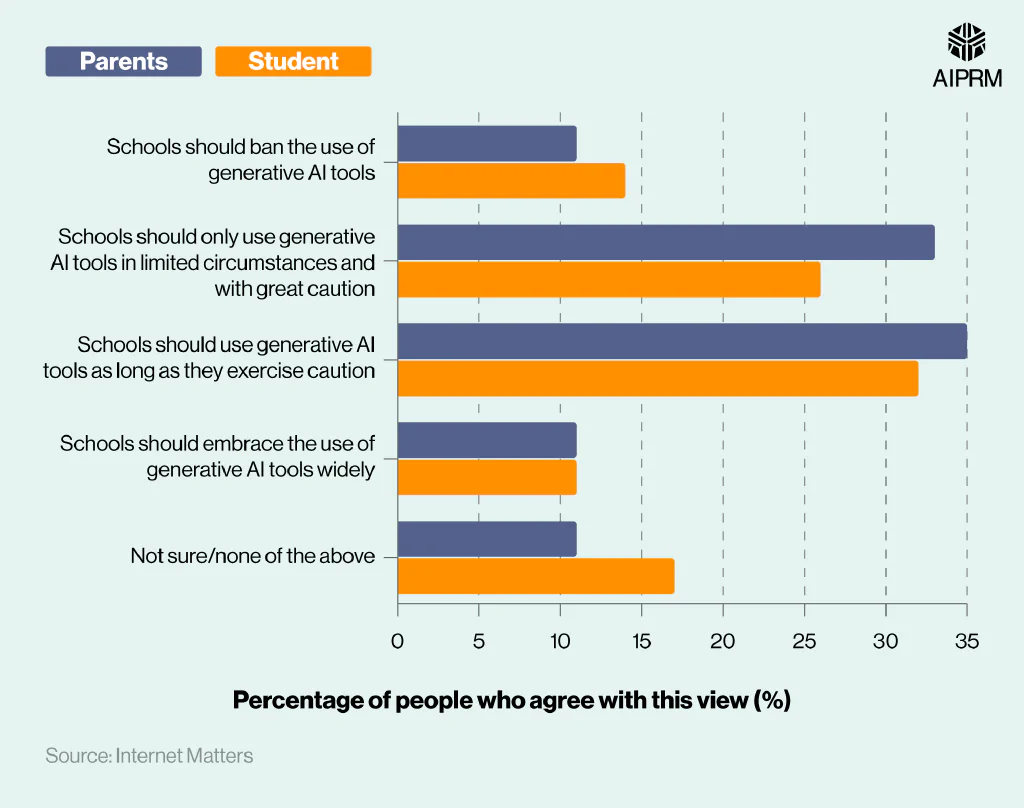
When comparing the attitudes of parents and students towards AI in education, it is the former that holds a slightly more positive outlook, according to generative AI statistics.
Around a tenth (11%) of parents feel schools should ban the use of generative AI tools – 3% less than students.
However, around a third of parents do feel that schools should only use generative AI tools in limited circumstances (33%) and only as long as they exercise caution (35%). The figures for students stand a little lower on the matter, at 26% and 32%, respectively.
A breakdown of parental attitudes toward AI in the education sector and how comfortable they feel with teachers using AI #
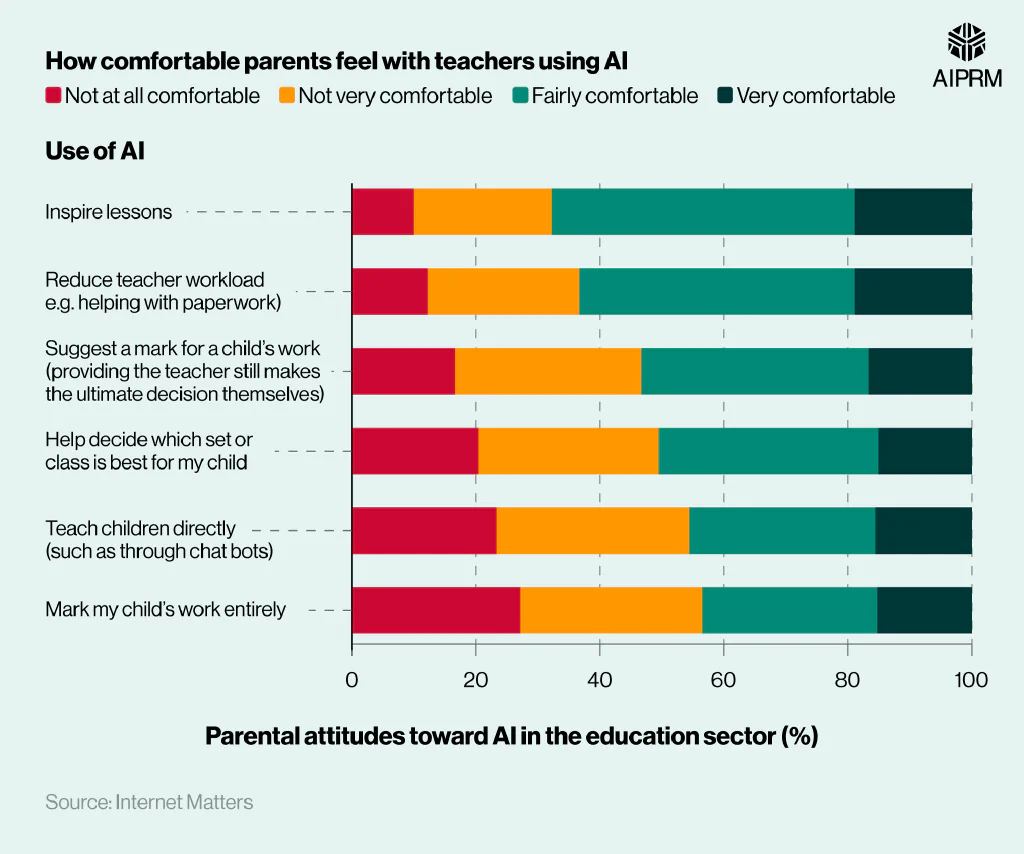
Generally speaking, parents seem to be more comfortable than uncomfortable when it comes to teachers using AI in education.
Research by Internet Matters found that:
- Around three-fifths (61%) of parents are comfortable with teachers using AI to inspire lessons, compared to less than a third (29%) who aren’t.
- Almost three-fifths (57%) of parents feel safe with teachers using AI to reduce workload (such as paperwork) compared to a third (33%) who would prefer them not to.
- Less than half (48%) are happy with teachers using AI to suggest a mark (providing the teacher still makes the ultimate final decision), whereas two-fifths (42%) are against this idea.
However, the report did highlight some findings that parents were more uncomfortable with when it comes to the use of AI by teachers.
Almost half (49%) didn’t like the idea of their child(ren) being taught directly through chatbots, as opposed to two-fifths (41%) who were comfortable with this. Similarly, more than half (52%) of parents expressed concerns about AI taking over the marking of work from teachers, with two-fifths (40%) admitting they would be comfortable with this happening.
Future of AI in education #
Almost three-fifths (57%) of people surveyed by the EdWeek Research Center feel that the use of AI in education will increase going into the future.
A breakdown of the perceived future of AI in education #
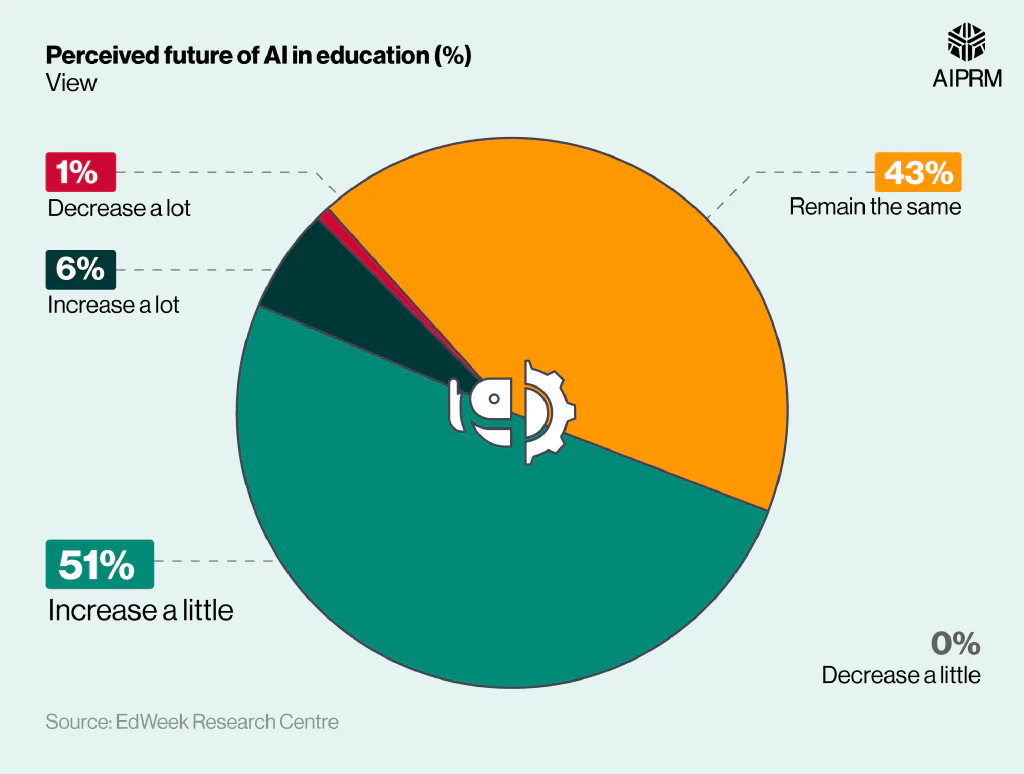
Just over two-fifths (43%) believe AI usage in education will remain the same, with just 1% of the opinion that it will decrease.
A breakdown of future AI use in the classroom (2024-25 vs 2023-24) #
| View | Percentage of respondents (%) |
|---|---|
| Less | 1% |
| About the same | 25% |
| More | 73% |
| Not sure | 2% |
(Source: RAND, American School District Panel, and CRPE)
Between 2023-25, around three-quarters (73%) of people believe AI will become more popular in the classroom, with a quarter (25%) thinking it will likely stay the same.
A breakdown of the extent to which teachers think students should be educated on the ethical use of AI #
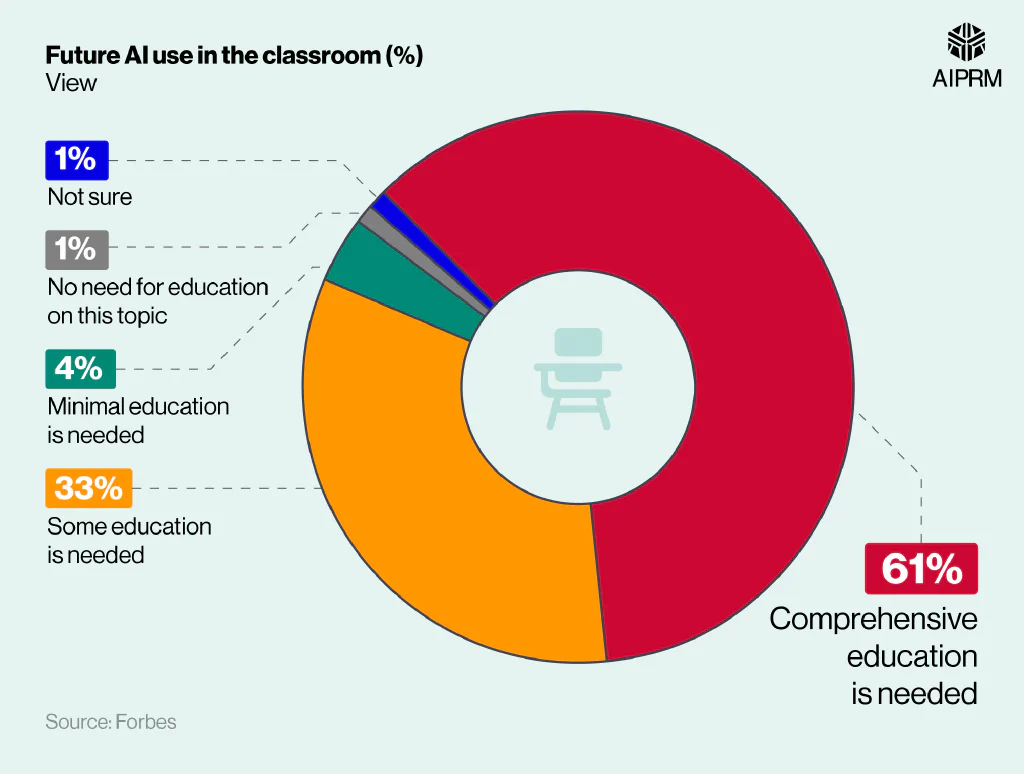
An astounding 98% of teachers surveyed by Forbes feel that students need some degree of education concerning the ethical uses of AI.
Around two in five (61%) believe that comprehensive education is required, with a third (33%) of the opinion that some level of education is needed on the matter.
A breakdown of how teachers think AI in education will evolve over the next decade #
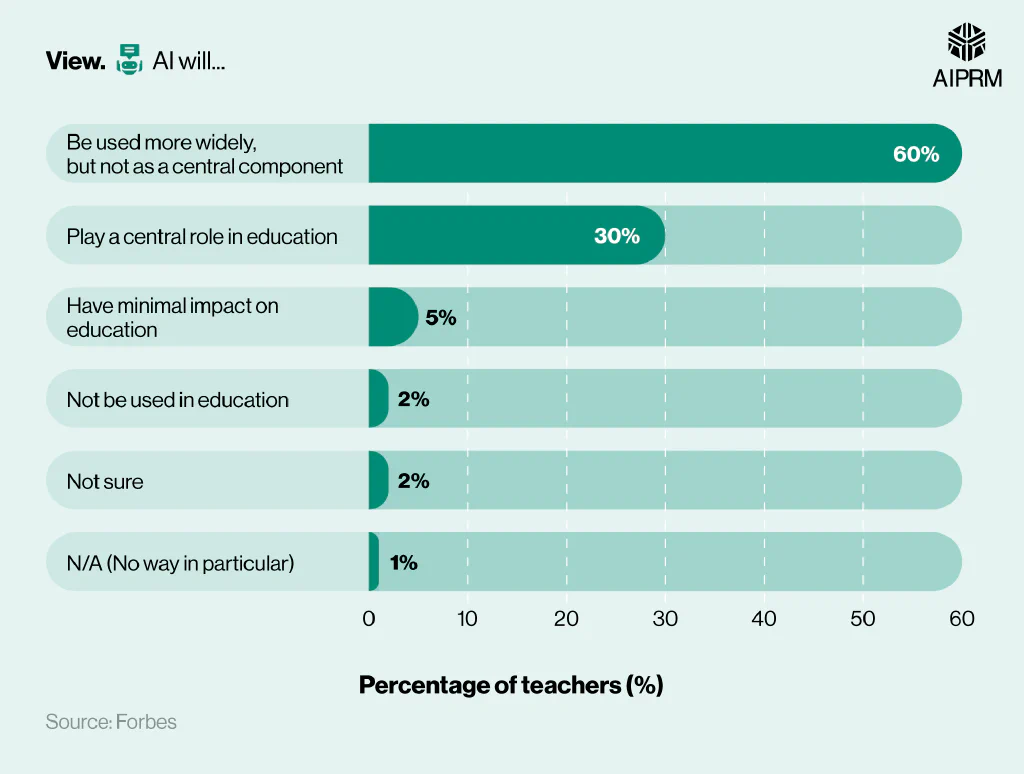
Over the coming decade, three-fifths (60%) of teachers surveyed by Forbes feel that AI will be used more widely in education, but not necessarily a central component.
Around half this amount (30%) believe AI will play a central role in the education sector between 2024-34, with around one in 20 (5%) of the opinion that its impact will be minimal.
A breakdown of potential barriers to future AI use in classrooms #

According to research by RAND, American School District Panel, and CRPE, the biggest barrier facing the future use of AI in classrooms stems from concerns about the role of AI in wider society. This is a notion felt by more than two-fifths of AI users (42%) and non-AI users (44%).
More than a third (36%) of people surveyed were also worried about data privacy and lack of professional development for using AI tools and products (34-35%).
Almost two-fifths (38%) of AI users were also concerned about the lack of school or district guidance when it came to using AI in the classroom. This was an opinion held by less than a third (30%) of non-AI users.
Check out our blog for the latest AI statistics and industry trends in the world of artificial intelligence
AI in education FAQS #
Should we use AI in education?
Yes, we should embrace the use of AI in education, but exercise an element of caution as to how it is used and how often. AI is there to help aid and assist teachers in delivering an engaging, fulfilling, and robust curriculum, but should not come at the expense of high-quality teaching and learning practices and reduced human interactions.
Why use AI in education?
AI in education should be used as a tool to help facilitate effective teaching and learning, both inside and outside of the classroom. It has the potential to provide different ways of learning, while simultaneously helping teachers with lesson planning, marking, and other administrative tasks.
What is one concern raised about the use of AI tools in education?
According to a 2024 survey by Forbes, one concern raised by teachers regarding the use of AI tools in education was plagiarism. Almost two-thirds (65%) of educators believe this to be the primary issue in their establishments when it comes to managing the potential negative side effects of AI tools in the classroom and beyond.
How does AI help teachers in education?
AI can help teachers in education in many ways, including:
- Using AI-powered educational games to make learning more interactive and lesson planning more efficient.
- Assistance with administrative tasks (such as data tracking and managing schedules) to allow more time for developing teaching strategies and resources
- Reduce marking time
- Automatically differentiate work for different ability levels.
How does AI help students in education?
AI can help students in education in several ways, including:
- Providing personalized learning experiences that are tailored to their styles of learning and gaps in their knowledge
- Generate instant feedback that can be used immediately on their next piece of work
- Develop skills in digital literacy, critical thinking, creativity, and problem-solving
- Make lessons more engaging and provide alternative ways to explain key themes and concepts
- Using chatbots and virtual assistants to provide help during out-of-school hours and when educators are unavailable.
How will AI affect education in the future?
It’s widely believed that AI will affect education in several ways in the future. It can support education by automating certain administrative tasks, thus freeing up time for staff and students to focus on other aspects. Teachers should therefore have more time to provide personalized support and mentoring, while students should have more time to work on the areas they need to develop.
For further information, feel free to contact us to see how AIPRM can help support your journey in education for the best possible outcomes.
Glossary #
Artificial intelligence (AI) #
The ability of machine and/or computer systems to mimic and simulate human capabilities such as communication, learning, and decision-making.
AI ethics #
Helping to ensure people use technology responsibly by adopting and implementing systems that promote a safe, secure, and unbiased approach to artificial intelligence.
Algorithm #
A sequence of rules given to an AI machine to perform a task or solve a problem.
Chatbot #
A software application designed to imitate human conversation via text or voice commands.
Deep learning #
A function of AI designed to imitate the human brain by learning how it processes unstructured information without supervision to make decisions.
Generative AI #
A type of technology that uses AI to create content, such as text, video, images, and code. It can find patterns within large datasets to generate this new content.
Hallucination #
When an incorrect response from an AI generates an output of false information that is presented as factual information.
Machine learning #
A function of AI that uses computer science, mathematics, and coding elements to develop algorithms and models. These are designed to learn from data, analyze trends, and predict future trends without human assistance.
Natural language processing (NLP) #
A form of AI that enables computers to understand spoken and written human language, such as text and speech recognition software on electronic devices.
Sources and methodology #
https://www.alliedmarketresearch.com/artificial-intelligence-in-education-sector-market
https://link.springer.com/article/10.1007/s40593-023-00352-3
https://www.nafsa.org/ie-magazine/2024/1/10/generative-ai-and-global-education
https://www.internetmatters.org/hub/research/generative-ai-in-education-report/#full-report
https://www.rand.org/pubs/research_reports/RRA956-21.html
https://crpe.org/ai-is-coming-to-u-s-classrooms-but-who-will-benefit/
https://axonpark.com/how-effective-is-ai-in-education-10-case-studies-and-examples
https://hai.stanford.edu/news/using-artificial-intelligence-understand-why-students-are-struggling
https://d3.harvard.edu/platform-digit/submission/knewton-personalizes-learning-with-the-power-of-ai/
https://edu.google.com/why-google/customer-stories/ivytech-gcp/
https://www.datamation.com/artificial-intelligence/how-ai-is-being-used-in-education/
https://www.sciencedirect.com/science/article/pii/S2666920X24000560?via%3Dihub
https://www.statista.com/statistics/1455421/us-views-on-allowing-k-12-students-to-use-ai/
https://www.statista.com/statistics/1462512/opinion-ai-effect-education-age-group-united-states/
https://www.statista.com/statistics/1462497/opinion-ai-effect-education-gender-united-states/
https://www.forbes.com/advisor/education/it-and-tech/artificial-intelligence-in-school/